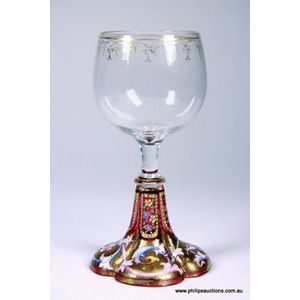Jewelled Moser Glass Goblet, Circa 1900
You must be a subscriber, and be logged in to view price and dealer details.
Subscribe Now to view actual auction price for this item
When you subscribe, you have the option of setting the currency in which to display prices to $Au, $US, $NZ or Stg.
- Circa - A Latin term meaning 'about', often used in the antique trade to give an approximate date for the piece, usually considered to be five years on either side of the circa year. Thus, circa 1900 means the piece was made about 1900, probably between 1895 and 1905. The expression is sometimes abbreviated to c.1900.
- Quatrefoil - A stylised four-circle design, itself contained within a larger circle, with Gothic origins and often seen as window designs in ecclesiastical architecture. The use of the motif was popular in Gothic Revival furniture of the 19th century.
- Gilding - Gilding is a method of ornamentation whereby a thin sheet of gold metal is applied to items made of wood, leather, ceramics, glass and silver for decorative purposes.
For furniture including mirrors, the sheet of gold is usually applied over a coating of gesso. Gesso is a mixture of plaster of Paris and gypsum mixed with water and then applied to the carved wooden frames of mirrors and picture frames as a base for applying the gold leaf. After numerous coats of gesso have been applied, allowed to dry and then sanded a coat of "bole", a usually red coloured mixture of clay and glue is brushed on and allowed to dry, after which the gold leaf is applied. Over time parts of the gilding will rub off so the base colour can be seen. In water gilding, this was generally a blue colour, while in oil gilding, the under layer was often yellow. In Victorian times, gilders frequently used red as a pigment beneath the gold leaf.
Metal was often gilded by a process known as fire gilding. Gold mixed with mercury was applied and heated, causing the mercury to evaporate, the long-term effect of which was to kill or disable the craftsman or woman from mercury poisoning. The pursuit of beauty has claimed many victims, not the least of which were the artists who made those pieces so highly sought after today.
This item has been included into following indexes:
Visually similar items

A fine Moser glass jewelled goblet, circa 1900, with a plain bowl above an embellished glass quatrefoil trumpet stem, each lobe with panels of flowers and tendrils within jewelled borders, the border extravagantly embellished with scrolling foliage in colo

A fine Moser glass jewelled goblet, circa 1900, the goblet with a clear bowl with gilded decoration to the rim above an embellished quatrefoil trumpet ruby glass stem and base, with alternating panels of jewelled flowers to the stem and scrolling leaf form

A fine Moser glass jewelled goblet, circa 1900, with a plain bowl above an embellished glass quatrefoil trumpet stem, with alternating panels of jewelled oak leaves on a gilt ground and flowers and leaves in colours over clear cranberry glass, with dot and

A Victorian glass goblet with finely enamelled bowl
